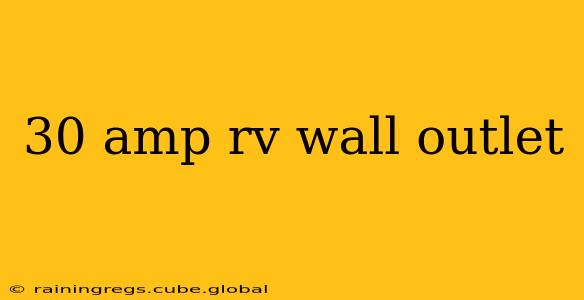Finding the right power source for your RV is crucial for a safe and enjoyable camping experience. A 30-amp RV wall outlet is a common power source for RVs and travel trailers, providing sufficient electricity for most appliances. But what exactly is a 30-amp RV wall outlet, and what do you need to know before using one? This comprehensive guide answers those questions and more.
What is a 30 Amp RV Wall Outlet?
A 30-amp RV wall outlet is a specialized electrical outlet designed specifically for recreational vehicles and other high-power appliances. It delivers 30 amps of power at 120 volts, significantly more than a standard 15-amp household outlet. This increased amperage is necessary to power the various appliances and systems commonly found in RVs, such as air conditioners, refrigerators, microwaves, and electric heaters. The outlet itself is distinctly shaped, featuring a distinctive 3-prong configuration (or sometimes a 4-prong configuration for additional grounding). This unique shape ensures that only compatible RV power cords can be plugged in, preventing accidental misconnections.
What are the Different Types of 30 Amp RV Outlets?
While the core functionality remains the same, you might encounter slight variations in 30-amp RV outlets:
- TT-30: This is the most common type of 30-amp RV outlet found in campgrounds and RV parks. It’s easily identifiable by its distinctive L-shaped configuration.
- RV Park Outlets: These are generally hardwired into the campground’s electrical system and offer a dedicated connection for your RV.
- Portable Generators: Some portable generators also offer 30-amp outlets, enabling you to power your RV independently from a campground’s electricity supply. However, be sure your generator is appropriately sized and that you understand the safety precautions involved in using generator power.
How to Safely Use a 30 Amp RV Wall Outlet
Using a 30-amp RV outlet safely is paramount. Here’s a breakdown of essential safety practices:
- Inspect the Outlet: Before plugging in your RV, carefully inspect the outlet for any signs of damage, such as loose wiring, cracks, or corrosion. If you notice any issues, don't use the outlet. Report it to the campground management immediately.
- Use the Correct Cord: Only use a properly rated RV power cord designed for 30-amp service. Using a cord with inadequate amperage rating can lead to overheating and potentially fire hazards.
- Avoid Overloading: Don’t attempt to run too many appliances simultaneously. Monitor your RV's power usage to avoid tripping the circuit breaker. Consult your RV’s owner’s manual for guidance on power management.
- Grounding: Ensure your RV is properly grounded to prevent electrical shocks. The grounding system plays a crucial role in safety.
What Happens if I Plug a 50 Amp RV into a 30 Amp Outlet?
Plugging a 50-amp RV into a 30-amp outlet is strongly discouraged. You risk overloading the circuit and potentially causing damage to the electrical system, potentially leading to a fire. Never attempt this. Instead, ensure you're using an outlet with a compatible amperage rating.
Can I Use a 30 Amp RV Outlet with a 15 Amp Appliance?
Yes, you can generally use a 30-amp RV outlet with a 15-amp appliance. However, the appliance will only draw the power it requires, up to its 15-amp limit. You won't be drawing the full 30 amps the outlet provides.
How Much Power Does a 30 Amp RV Outlet Provide?
A 30-amp RV outlet provides 3600 watts of power (30 amps x 120 volts). This is a crucial figure to consider when planning your power usage and determining whether it meets your RV’s needs.
What Appliances Can I Run on a 30 Amp RV Outlet?
Most smaller RVs and travel trailers operate comfortably on 30-amp service. You can typically run air conditioning (depending on the unit's power requirements), refrigeration, lighting, smaller microwaves, and some other appliances simultaneously, but always monitor your power consumption to avoid overloading.
Troubleshooting 30 Amp RV Outlet Issues
If you experience problems with a 30-amp RV outlet, troubleshoot by first checking your RV’s power cord for damage, then inspect the outlet itself for any visible issues. Consider also whether you've overloaded the circuit by running too many appliances. If the problem persists, contact the campground's management or an electrician.
By understanding the nuances of 30-amp RV wall outlets and following the safety guidelines, you can ensure a smooth and safe power supply for your RV adventures. Remember, always prioritize safety and consult a qualified electrician if you have any doubts or concerns.
